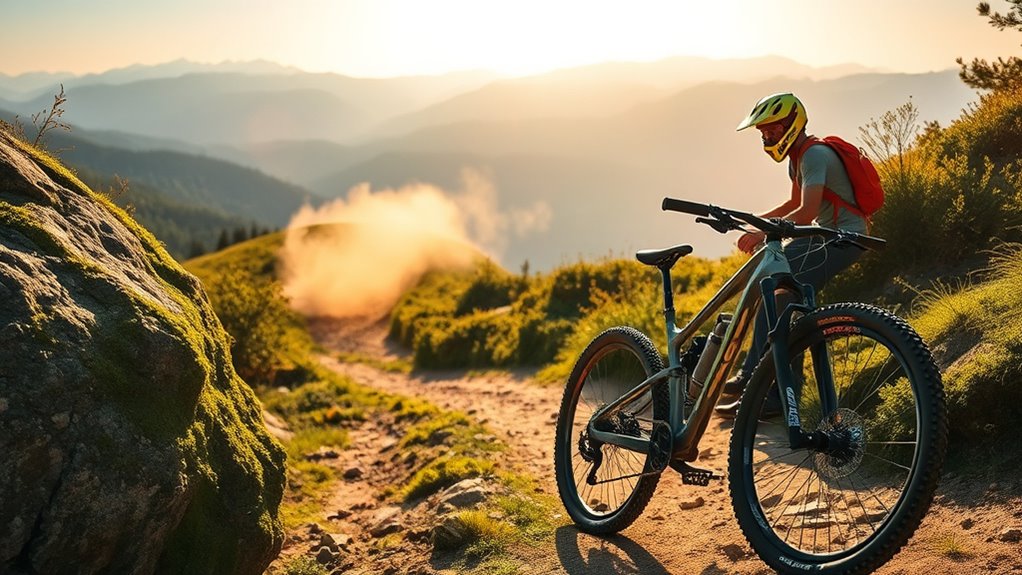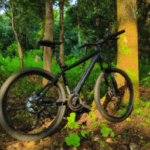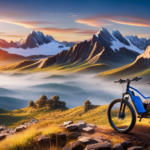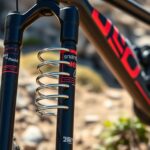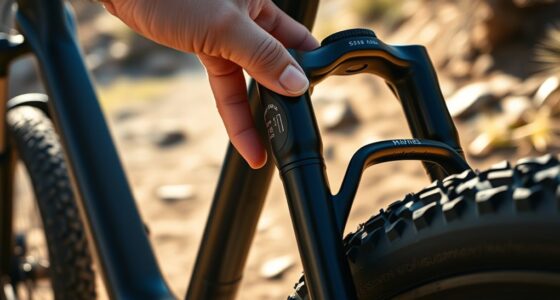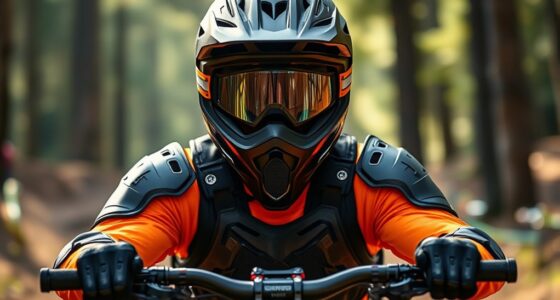Mountain biking’s all about adventure on two wheels, steering through everything from smooth paths to rugged trails. To start, you’ll want to choose a bike that fits your style, whether it’s cross-country or downhill. Understanding suspension types and wheel sizes will enhance your comfort. Don’t forget essential gear like a helmet and proper shoes for safety and performance. As you build your skills and confidence, you’ll find more challenges await on the trails ahead.
Key Takeaways
- Choose the right mountain bike style (cross-country, enduro, downhill) based on your skill level and riding preferences.
- Select between full-suspension and hardtail bikes depending on the terrain you’ll ride most frequently.
- Always wear a properly fitted helmet and consider additional safety gear like knee pads for protection.
- Familiarize yourself with local trails, matching them to your skill level for an enjoyable experience.
- Practice basic skills in safe areas to build confidence before tackling more technical trails.
What Is Mountain Biking?
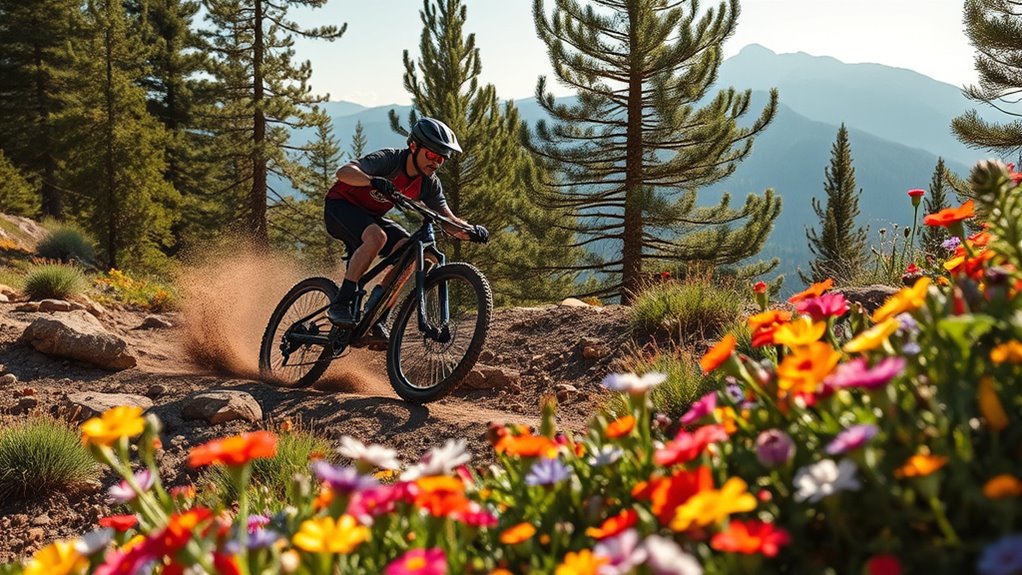
Mountain biking is an exhilarating outdoor adventure that involves riding bicycles on unpaved trails. This sport offers a unique mountain biking experience, as you navigate everything from smooth paths to rugged terrains.
Originating in the 1980s in California, mountain biking has evolved considerably, with advanced bike technology enhancing your ride. You’ll find bikes equipped with wider, knobbier tires for added stability and traction, as well as suspension systems that absorb shocks.
Whether you’re interested in cross-country, downhill, enduro, or freeride, each type of mountain biking presents its own set of challenges. To truly enjoy it, you’ll want to choose the right bike for the best performance, ensuring you can tackle any trail with confidence and skill. Additionally, understanding state tax implications can be crucial for those planning to invest in biking gear or trails as part of your outdoor lifestyle.
Types of Mountain Biking
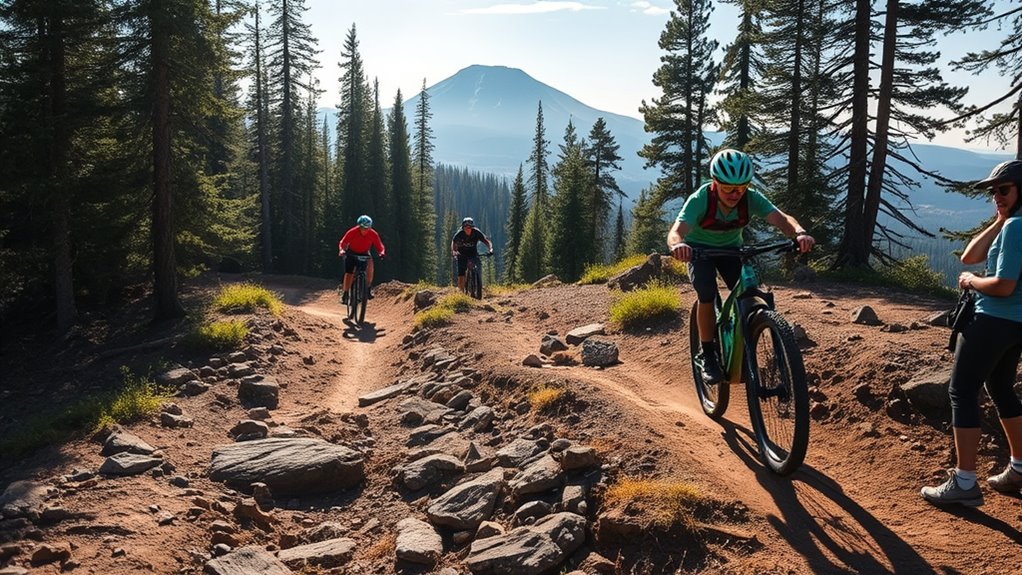
When exploring the world of mountain biking, you’ll discover various styles that cater to different skill levels and preferences.
Here are four popular types of mountain biking to take into account:
- Cross-Country (XC): This beginner mountain style focuses on less technical trails, perfect for building confidence on scenic singletrack.
- Enduro/All-Mountain: Combining XC pedaling with technical descents, this style features varied terrain and is often accessed via gondolas.
- Downhill (DH): Designed for steep descents, DH riding uses specialized, heavier bikes and typically occurs at lift-serviced parks.
- E-Mountain Biking: Ideal for those worried about stamina, these bikes offer assistance, making mountain biking more accessible.
Additionally, understanding astrological compatibility may enhance your overall biking experience by boosting your confidence and enjoyment on the trails.
Choosing the right style of mountain biking will enhance your experience and help you grow as a rider.
Choosing Your First Mountain Bike
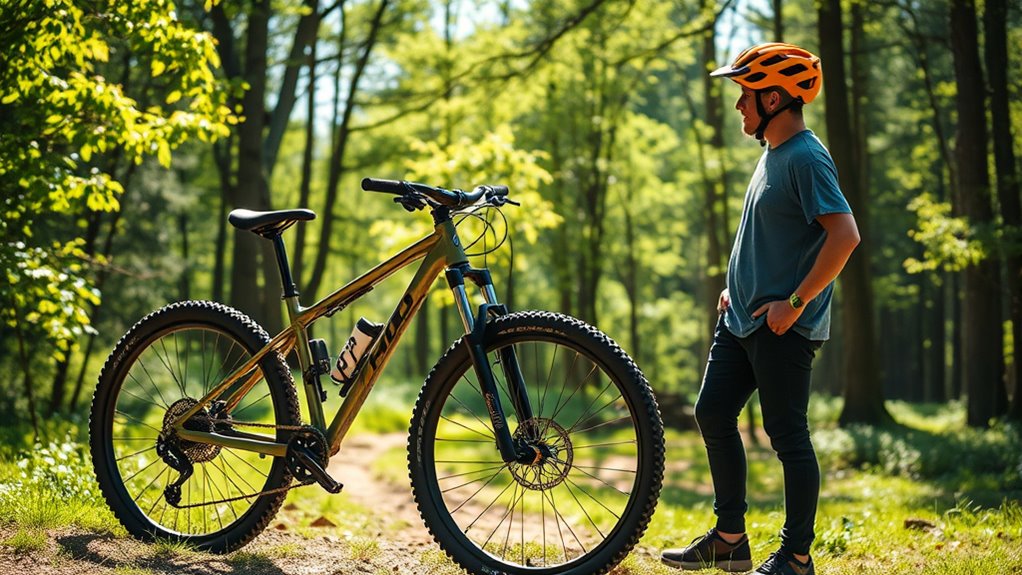
Selecting your first mountain bike can feel overwhelming, but it doesn’t have to be. Start by determining whether a full-suspension or hardtail model suits your riding style and terrain. Full-suspension bikes offer comfort on rough trails, while hardtails are lighter and great for climbing.
Next, pay attention to frame size; it’s vital for comfort and performance. Use the manufacturer’s sizing chart to find the right fit based on your height, typically ranging from XS to XL.
Consider the wheel size too—27.5-inch wheels strike a balance between maneuverability and rolling ability, while 29-inch wheels excel at overcoming obstacles. Additionally, ensure you evaluate brand reliability and customer reviews to make an informed decision.
Finally, test-ride different bikes at local shops to guarantee you make a well-informed choice before purchasing.
Suspension Types and Wheel Sizes
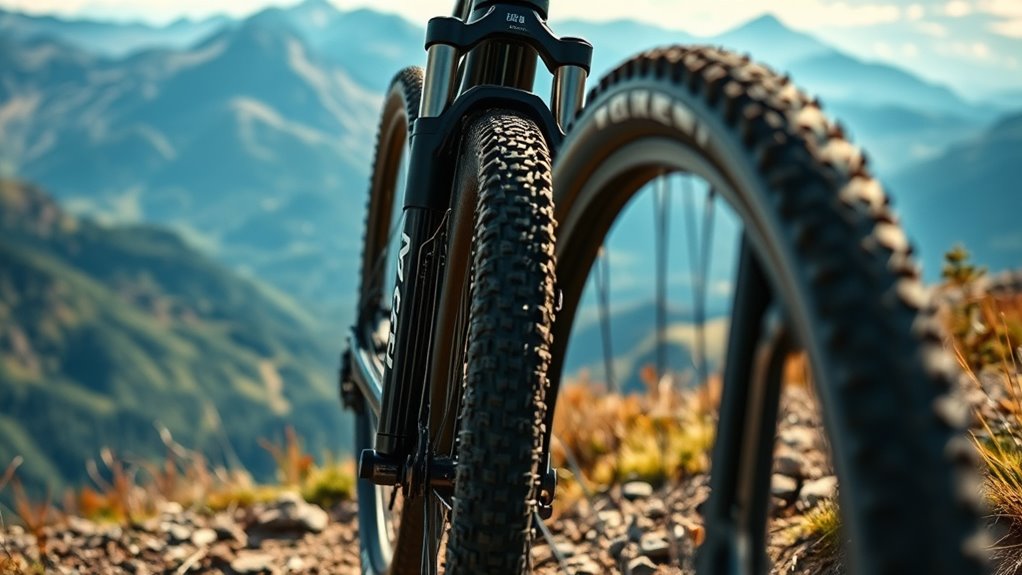
Understanding the differences in suspension types and wheel sizes is essential for finding the right mountain bike for your needs.
Here’s a quick overview:
- Rigid: No suspension; simple and cost-effective.
- Hardtail: Front suspension only; less maintenance and great for beginners.
- Full-suspension mountain bike: Offers both front and rear suspension; enhances comfort and traction on rough terrain, but may be heavier for climbing.
- Wheel Sizes: Choose between 26 inches, 27.5 inches, and 29 inches. Larger wheels roll over obstacles better, while smaller wheels provide improved maneuverability.
Selecting the right combination of suspension types and wheel sizes will greatly impact your riding experience, so consider your style and terrain before making a decision. Additionally, understanding proper disposal methods can help maintain the trails you ride on, ensuring a better experience for all.
Where to Ride Your Mountain Bike
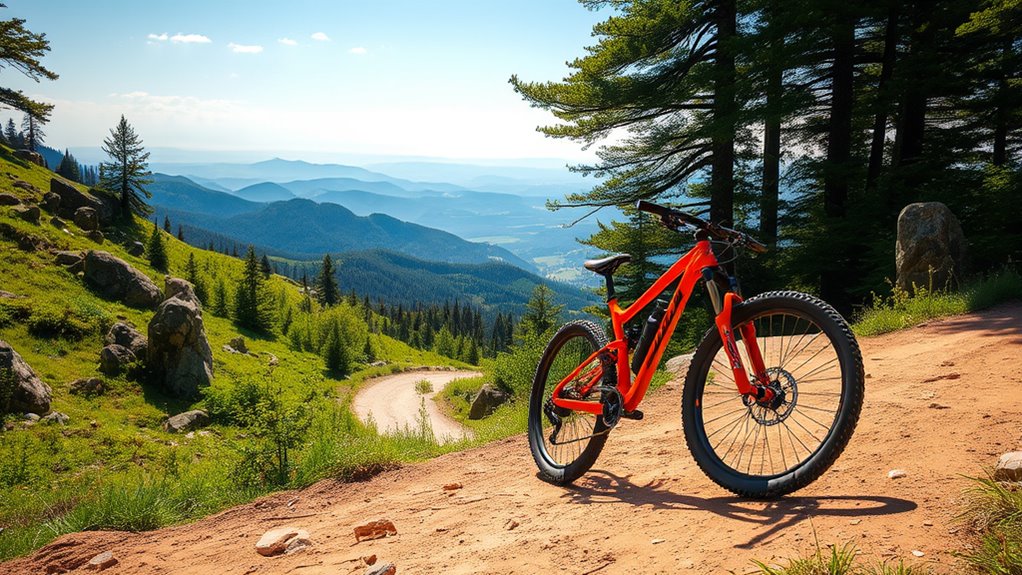
Now that you’ve got a handle on suspension types and wheel sizes, it’s time to explore where you can take your mountain bike for an adventure.
Look for mountain bike trails that match your skill level, from beginner-friendly trails marked with a green circle to advanced options with black diamonds. Singletrack trails offer a thrilling, immersive experience, while doubletrack trails provide easier, wider paths.
If you’re looking to hone your skills, consider visiting a skills park—these areas are designed for practice, featuring jumps and berms to help you improve.
Utilize resources like Trailforks and MTB Project to find trails, check conditions, and read user reviews. Additionally, consider incorporating self-watering planters in your home garden to promote plant health with minimal effort while you’re out riding.
Remember to practice trail etiquette to guarantee a positive experience for everyone!
Trail Difficulty Rating System
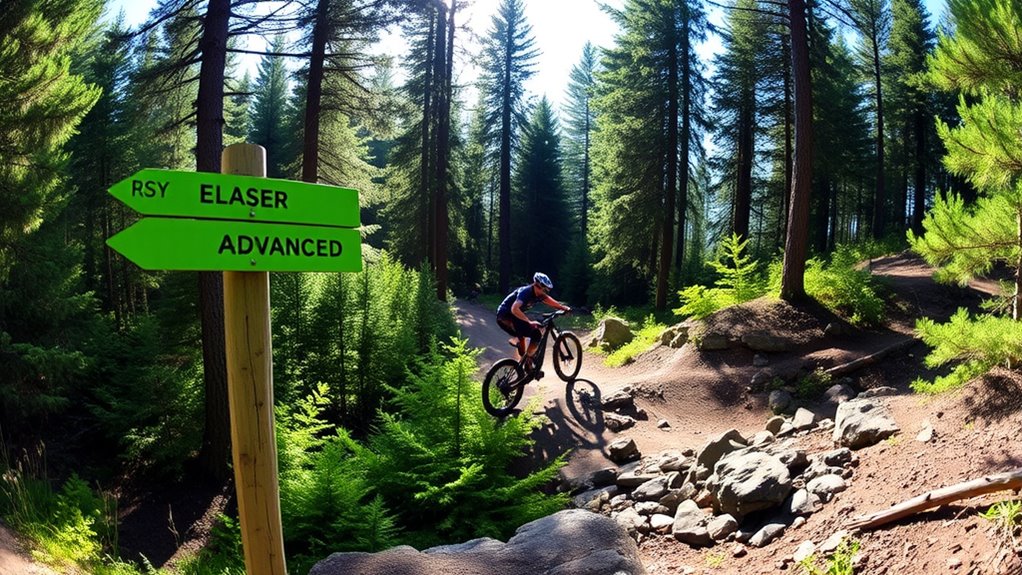
When you’re starting out, beginner trails are your best bet, with smooth surfaces and minimal obstacles.
As you gain confidence, you might want to tackle advanced trails, which feature steeper grades and bigger challenges.
Understanding these differences helps you choose the right trail for your skill level and guarantees a fun ride. Additionally, being aware of trail difficulty ratings can further assist in selecting suitable paths for your biking experience.
Beginner Trail Characteristics
Beginner trails, marked with a green circle, are perfect for those new to mountain biking.
These trails offer a welcoming environment with smooth surfaces and an average grade of no more than 5%. You won’t encounter intimidating obstacles in the trail, as most are only a couple of inches tall.
Here are some key characteristics:
- Surface: Primarily smooth and well-maintained.
- Grade: Average incline not exceeding 5%.
- Obstacles: Limited to heights of a few inches.
- Skill Level: No advanced skills required; great for practicing basic techniques.
Understanding these basics helps you build confidence as you start your mountain biking journey. Additionally, consider exploring local parks that often have beginner-friendly trails for a more enjoyable experience.
Always check local assessments for specific trail conditions!
Advanced Trail Features
As you progress in your mountain biking journey, understanding the trail difficulty rating system becomes essential for selecting the right paths that match your skills.
Advanced trails, marked with a black diamond, offer a significant challenge designed for riders with a higher skill level. These trails feature steep grades of up to 15% and include technical features such as rocky sections, roots, and obstacles reaching 15 inches tall.
You’ll need to demonstrate control and confidence while maneuvering through these elements. If you’re ready to tackle more complex terrain, advanced trails will push your abilities, helping you refine your technical skills and improve your overall riding experience. Additionally, just like how color accuracy impacts overall image quality in projectors, mastering advanced trails can greatly enhance your biking experience.
Always assess your readiness before hitting these challenging paths!
Essential Mountain Bike Gear and Accessories
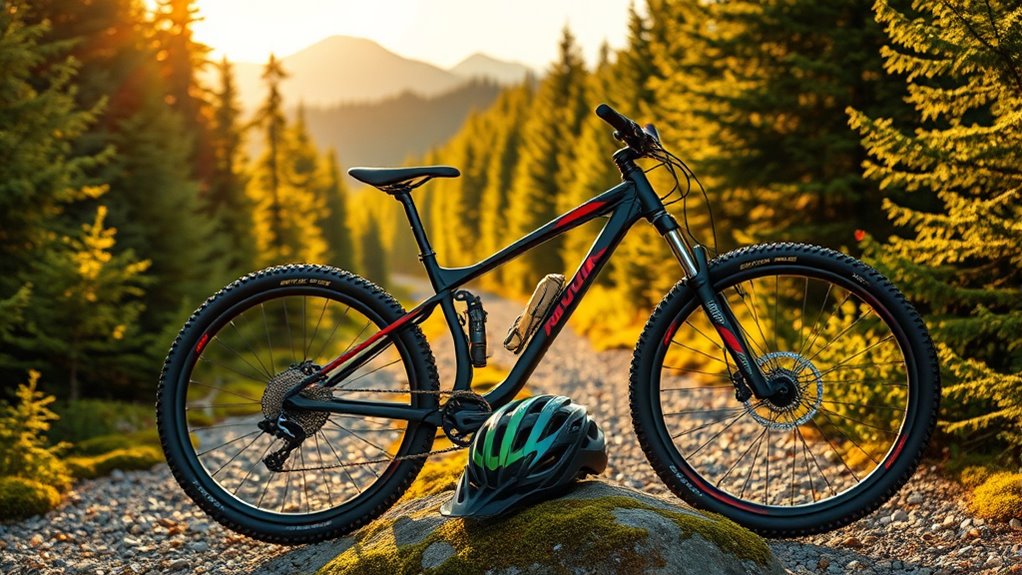
Here’s a list of essential mountain bike gear and accessories you shouldn’t overlook:
- Mountain bike helmets: A properly fitted helmet is essential, especially full-face models for downhill rides, with MIPS technology for added protection.
- Mountain bike shoes: Choose shoes with stiffer soles for better grip and support; consider flat pedals for beginners or clipless pedals for advanced control.
- Protective gear: Knee and elbow pads are important for safeguarding against falls, particularly on technical trails.
- Comfortable apparel: Wear shorts with chamois liners to prevent chafing and enhance comfort during long rides.
Don’t forget accessories like hydration packs, gloves, and sunglasses to boost your safety and overall experience! Incorporating hydration strategies during your rides can also significantly improve your endurance and performance.
Mountain Bike Shoes and Pedals
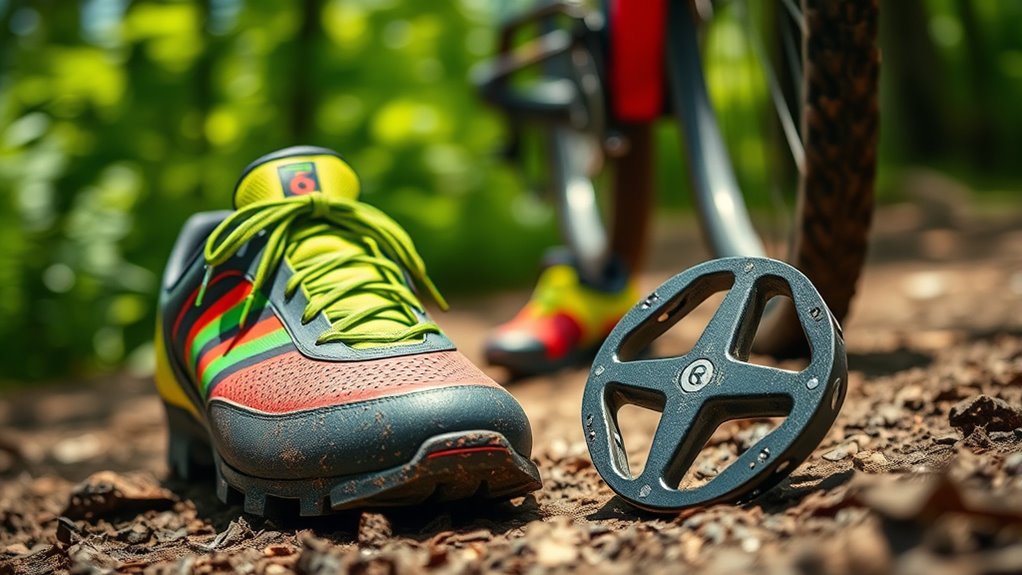
Finding the right mountain bike shoes and pedals can greatly enhance your riding experience.
Mountain bike shoes are designed with stiffer soles, providing support and improving power transfer, making your rides more comfortable. You can choose clipless pedals, which allow you to attach your shoes directly for better control and efficiency, but mastering the connection takes practice.
Alternatively, flat pedals are perfect for beginners, offering quick foot placement and helping you refine your technique without needing special shoes.
Many mountain bike shoes feature sticky rubber soles for enhanced grip on the pedals and rugged terrain, ensuring stability. Additionally, selecting shoes compatible with EPA-certified wood stoves can further improve your outdoor experience by promoting sustainable practices in your riding environment.
Safety Gear Recommendations
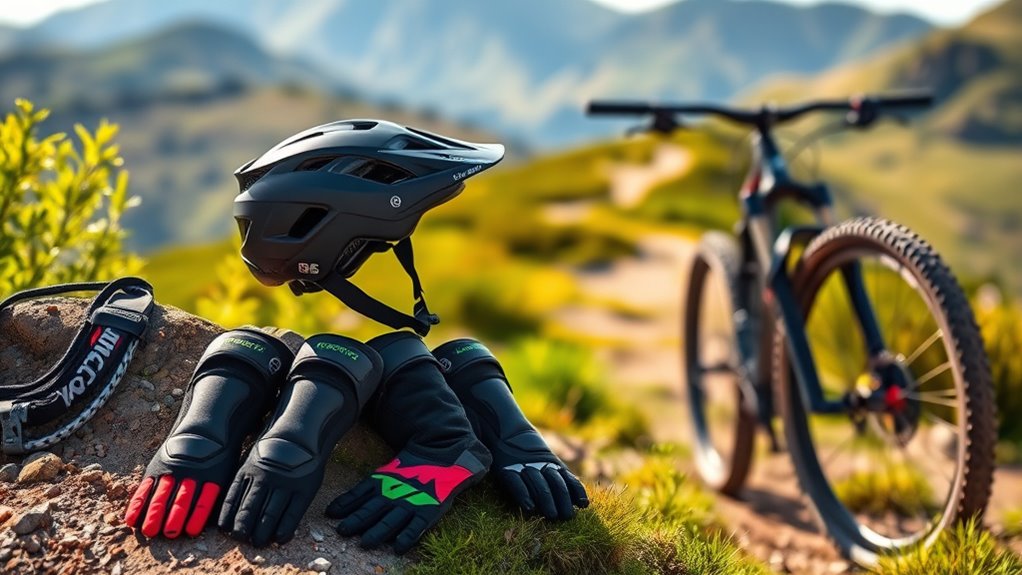
Safety gear is essential for a safe and enjoyable mountain biking experience. To protect yourself effectively, consider these recommendations:
Safety gear is crucial for a secure and enjoyable mountain biking adventure. Prioritize your protection with the right equipment.
1. Helmet: Opt for a properly fitted mountain bike Helmet, preferably one with MIPS technology to reduce rotational forces during impacts.
For downhill riding, invest in full-face helmets for added jaw and face protection.
2. Knee and Elbow Pads: These absorb impacts and prevent injuries, especially during technical or downhill rides.
3. Gloves: Mountain bike Gloves enhance grip, protect against abrasions, and improve control over the handlebars.
4. Fit and Comfort: Always choose safety gear based on fit and comfort, as this boosts your confidence and enjoyment on the trails.
Tips for Improving Your Skills and Confidence
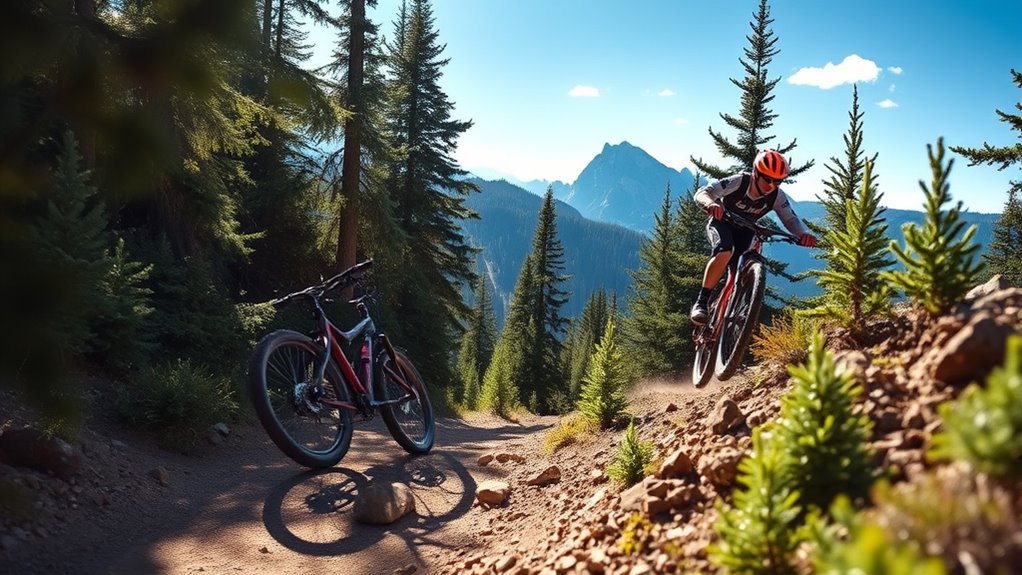
Improving your skills and confidence on the trails is all about practice and incremental challenges. Start by honing your basic skills in a safe space, focusing on body positioning, braking techniques, and gear shifting. Gradually tackle more technical trails to build your confidence.
| Skill Level | Focus Areas | Tips |
|---|---|---|
| Beginner | Basic skills | Practice in a flat area |
| Intermediate | Body positioning | Adjust your stance on climbs |
| Advanced | Technical trails | Ride with experienced bikers |
Consider taking lessons at local bike parks for personalized feedback. Regularly watch online tutorials to visualize techniques, helping you refine your skills even off the bike. This way, you’ll be ready for any trail challenge!
Frequently Asked Questions
How to Start Mountain Biking as a Beginner?
To start mountain biking as a beginner, familiarize yourself with essential bike components to guarantee you choose the right bike.
Begin practicing on easy trails marked with green circles to build your confidence.
Adjust your bike for a proper fit, enhancing comfort and efficiency.
Don’t forget to invest in safety gear like a helmet and knee pads.
Finally, use apps to find beginner-friendly trails, helping you gradually challenge yourself as you improve.
Does Mountain Biking Burn Belly Fat?
Yes, mountain biking can definitely help you burn belly fat! It’s an intense workout that combines aerobic and anaerobic exercise, effectively increasing your metabolism.
As you tackle varied terrains, you engage different muscle fibers, maximizing fat loss. Incorporating intervals—switching between high-intensity bursts and moderate cycling—can further boost calorie burn.
What Is the Most Common Injury in Mountain Biking?
The most common injury in mountain biking is related to falls, particularly shoulder injuries like dislocations and fractures.
You’ll find that about 30% of injuries involve your upper extremities, including wrists and elbows. Knee injuries, often stemming from improper bike fit or technique, are also frequent.
Don’t forget about head injuries; wearing a properly fitted helmet is essential for your safety.
As a novice, be mindful of your skill level to avoid risky terrains.
Is 60 Too Old to Start Mountain Biking?
No, 60 isn’t too old to start mountain biking!
In fact, many riders begin at this age, enjoying both physical fitness and mental well-being.
You’ll find plenty of trails suited for all skill levels, including those that are less technical.
Plus, e-bikes can make your rides easier by offering pedal assistance.
Conclusion
So, you’re now armed with the basics of mountain biking—congratulations! You’re ready to tackle those trails like a pro…or at least like someone who’s seen a pro on YouTube. Remember, it’s all about looking cool while maneuvering those rocks and roots, right? Just don’t forget that falling is part of the experience—every champion has a collection of bruises to prove it! So, gear up, get out there, and embrace the glorious chaos that is mountain biking!
